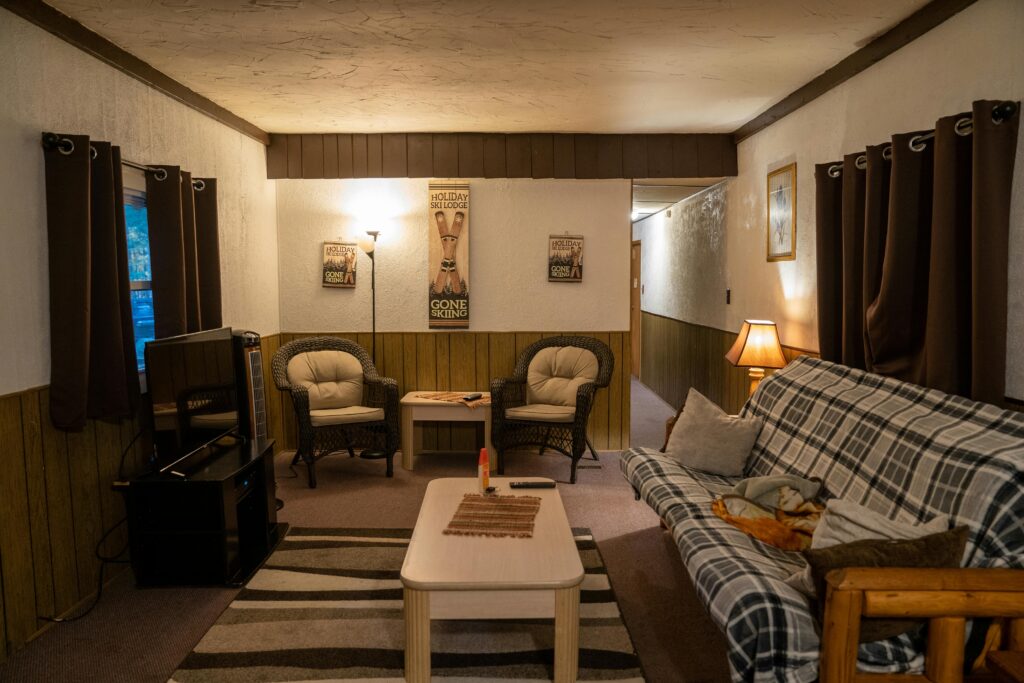Modern living room design is characterized by its emphasis on simplicity, clean lines, and a minimalistic approach. The aesthetic is clutter-free and focuses on the ideology of “less is more.” This style often incorporates a neutral color palette with shades of whites, grays, and blacks, punctuated by bold colors used sparingly as accents.
Contents
Understanding Modern Living Room Design
Furniture: Modern furniture typically features sleek, clean lines without much detailing. Materials like metals, glass, and polished woods are common, giving the space a more industrial feel. Furniture is often low-profile, emphasizing horizontal lines across the room.
Layout: A modern living room prioritizes function, favoring open spaces that are free of clutter. The arrangement is straightforward, with furniture often centered around a focal point like a large window or a wall-mounted television.
Decor Elements: In modern decor, less is more. Decorative items are kept to a minimum, with art pieces and accents chosen for their bold impact rather than their quantity. Lighting fixtures in modern designs are often pieces of art in themselves, featuring abstract or geometric shapes.
Embracing Traditional Living Room Design
Traditional living room design draws heavily from classic European decor, particularly from the 18th and 19th centuries. It is known for its detailed craftsmanship, rich color schemes, and a warm, inviting atmosphere.
Furniture: Traditional furniture is often ornate with intricate wood carvings and rich fabric upholstery. Pieces like wing-backed chairs, clawfoot sofas, and ornate coffee tables are staples. The furniture arrangement in traditional designs frequently encourages conversation, with chairs and sofas facing each other.
Layout: Unlike the open, sparse layout of modern designs, traditional living rooms focus on coziness and comfort. The spaces are more segmented, with furniture grouped in intimate settings. Accessories like bookshelves, cabinets, and curio cases are more prevalent, adding to the room’s character.
Decor Elements: Traditional rooms revel in the beauty of accessorizing. Curtains, throw pillows, rugs, and artwork are abundant and rich in color and texture. Lighting is typically soft and layered, using table lamps, sconces, and chandeliers to create a warm glow.
Deciding Between Modern and Traditional
When deciding between modern and traditional living room designs, consider the following factors:
1. Personal Style: Your personal taste should be the primary influence in your decision. If you prefer a cleaner, more streamlined look, modern design might be right for you. If you enjoy richness in detail and history in your decor, traditional design might be more appealing.
2. Lifestyle: Consider how you use your living room. Modern designs can suit those who favor minimal upkeep and a more formal atmosphere. Traditional designs are often better for homes with children and pets, as they prioritize comfort and durability.
3. Home Architecture: The architecture of your home can also influence your choice. A modern home with lots of glass and steel might suit a modern living room better, whereas a house with more classic architectural features such as crown moldings and hardwood floors might harmonize better with a traditional design.
4. Mixing Elements: You don’t have to strictly choose one style over the other. Many beautiful living rooms blend modern and traditional elements. For example, pairing a modern sofa with a traditional rug can create a dynamic, eclectic look.
Choosing between a modern or traditional living room design comes down to your personal preference, lifestyle, and the character of your home. Each style offers distinct benefits, whether it’s the clean, bold feel of modern decor or the warm, ornate touch of traditional settings. By considering your needs and what each style offers, you can create a living room that is not only stylish but also a perfect fit for your everyday life.

